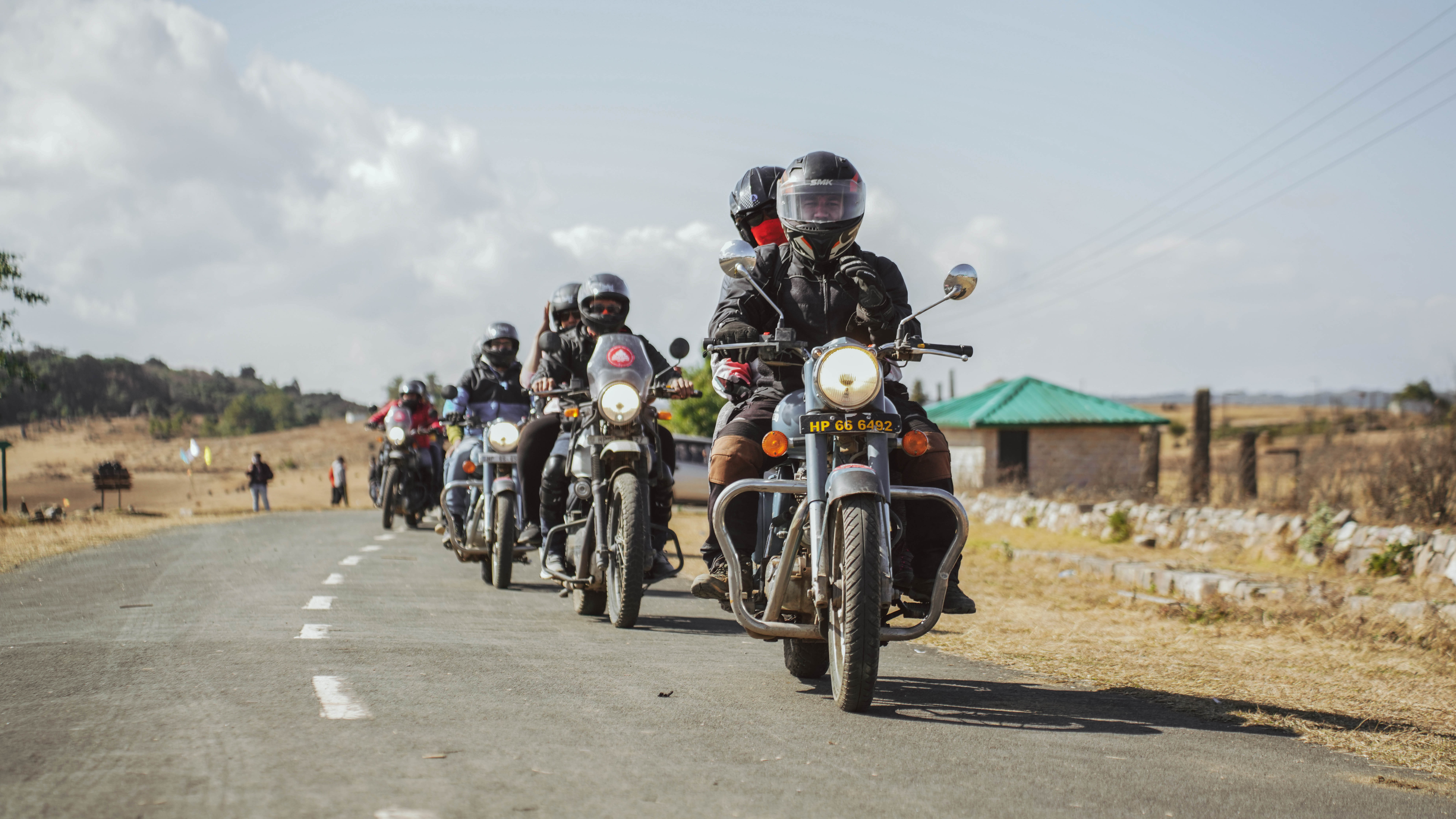 12th December 2024
12th December 2024
India, with its diverse landscapes and vibrant culture, offers some of the most exhilarating biking routes for adventure enthusiasts. Whether you're navigating the rugged terrains of the Himalayas, cruising along serene coastal roads, or exploring the vibrant deserts, India has something for every biker. Here are some of the best biking routes and tours you can explore:
Highlights:
Iconic high-altitude passes like Rohtang La, Baralacha La, Tanglang La, and Khardung La.
Stunning landscapes featuring barren mountains, rivers like the Indus and Zanskar, and alpine meadows.
Best Time: June to September (roads are open and weather is manageable).
Experience:
This route is known for its challenging terrain, unpredictable weather, and stunning scenery.
Must-visit spots include Pangong Lake, Nubra Valley, and Magnetic Hill.
Tips:
Prepare for altitude sickness by acclimatizing in Manali or Leh.
Carry essential spares, first-aid kits, and extra fuel.
Route: Shimla – Kalpa – Kaza – Manali (or reverse).
Highlights:
Villages like Langza (fossil hunting), Kibber (wildlife sanctuary), and Tabo (ancient monastery).
Mesmerizing landscapes of barren valleys, snow-capped peaks, and the Spiti River.
Best Time: May to October (roads are accessible and weather is favorable).
Experience:
A remote, raw, and rugged journey perfect for adventurers seeking solitude.
The circuit involves crossing high-altitude passes like Kunzum La and navigating rocky trails.
Tips:
Choose a lightweight and durable bike for tough terrain.
Homestays in Spiti offer a great opportunity to experience local culture.
Highlights:
Scenic roads along the Konkan coastline, lush green landscapes, and pristine beaches.
Stopovers like Alibaug, Tarkarli, and Ganpatipule provide a blend of adventure and relaxation.
Best Time: October to February (pleasant weather).
Experience:
The route offers a laid-back ride with plenty of opportunities for photography, seafood, and beach fun.
Tips:
Plan for beach stays and indulge in local Konkan cuisine.
Avoid the monsoon season as roads can become slippery.
Route: Jaipur – Jodhpur – Jaisalmer – Udaipur.
Highlights:
Explore historic forts, palaces, and the golden sand dunes of the Thar Desert.
Camel rides in Jaisalmer and cultural performances in Udaipur are major attractions.
Best Time: October to March (comfortable temperatures).
Experience:
A mix of desert roads, vibrant Rajasthani culture, and royal heritage.
Tips:
Stay hydrated and carry warm clothing for desert nights.
Visit during festivals like the Pushkar Camel Fair or Desert Festival in Jaisalmer.
Highlights:
Lush green landscapes, snow-covered passes like Sela Pass, and Buddhist monasteries.
Visit Tawang Monastery, Asia's second-largest monastery.
Best Time: March to May or October to November (clear skies and pleasant weather).
Experience:
A serene yet challenging ride with steep ascents, hairpin bends, and misty forests.
Tips:
Secure permits for Arunachal Pradesh.
Be prepared for sudden weather changes in the mountains.
Highlights:
Tea gardens of Munnar, spice plantations, and serene backwaters of Alleppey.
Wildlife spotting in Thekkady.
Best Time: September to March (cool weather and lush greenery post-monsoon).
Experience:
A peaceful ride through picturesque landscapes, perfect for nature lovers.
Tips:
Stop at eco-tourism spots and enjoy a houseboat stay in Alleppey.
Avoid peak monsoon due to heavy rains.
Route: Gangtok – Zuluk – Nathang Valley – Kupup.
Highlights:
32 hairpin bends in Zuluk and panoramic views of Mt. Kanchenjunga.
Tranquil villages and high-altitude lakes like Tsomgo Lake.
Best Time: April to June and September to November.
Experience:
A lesser-explored but stunning route that combines natural beauty and history.
Tips:
Carry enough warm clothing for chilly nights.
Check road conditions as landslides can occur during monsoons.
Route: Bhuj – Dholavira – Great Rann of Kutch.
Highlights:
The mesmerizing white salt desert, handicrafts of Kutch, and vibrant Rann Utsav.
Best Time: November to February (ideal for the Rann Utsav).
Experience:
Ride through the vast expanse of the salt desert and enjoy cultural festivities.
Tips:
Book accommodations early during the Rann Utsav.
Night rides under the full moon are a magical experience.
Route: Tezpur – Bomdila – Tawang – Dirang.
Highlights:
High-altitude roads, traditional villages, and natural beauty.
Visit the Tawang War Memorial and hot springs in Dirang.
Best Time: March to May or September to November.
Experience:
A mix of spirituality and adventure with breathtaking views at every turn.
Tips:
Fuel stations are sparse; plan accordingly.
Be cautious on narrow, steep roads.
Route: Leh – Kargil – Padum.
Highlights:
Less crowded than Ladakh, Zanskar offers pristine beauty and adventure.
Explore monasteries like Phugtal and Karsha.
Best Time: June to September.
Experience:
A remote and peaceful ride with challenging off-road stretches.
Tips:
Carry enough fuel as this route lacks petrol pumps.
Keep food supplies and tools for emergency repairs.
1. What are the best months for biking in India?
High-altitude regions (Ladakh, Spiti): June to September.
Desert areas (Rajasthan, Rann of Kutch): October to March.
Coastal and Southern India: October to February.
Northeast India: March to May and October to November.
2. What type of bike is suitable for these routes?
Adventure Bikes: Royal Enfield Himalayan, KTM Adventure, or Hero Xpulse are ideal for rugged terrains like Ladakh or Spiti.
Cruisers: Royal Enfield Classic, Thunderbird, or Bajaj Avenger work well for long highway rides.
Sports Bikes: Suitable for smooth highways but not recommended for off-road routes.
3. Do I need a permit for any of these routes?
Ladakh: Inner Line Permits for Nubra Valley, Pangong Lake, and Tso Moriri.
Arunachal Pradesh: Protected Area Permit (PAP) for foreign nationals and Inner Line Permit (ILP) for Indian citizens.
Sikkim: Permits for Zuluk, Nathula Pass, and other restricted areas.
4. How do I prepare for high-altitude routes like Ladakh and Spiti?
Acclimatize properly to prevent altitude sickness.
Carry sufficient water, warm clothing, and basic medicines.
Maintain physical fitness and ensure your bike is in excellent condition.
 Chat Now
Chat Now